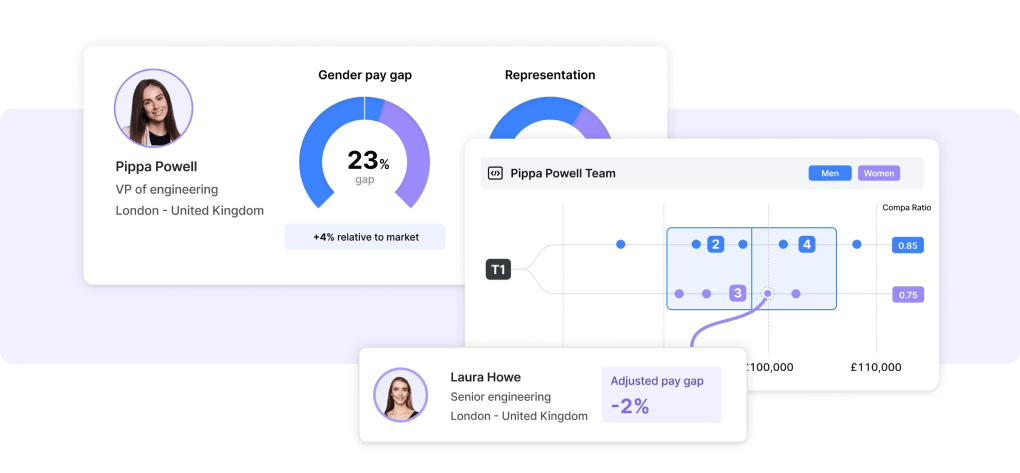Without clear guiding principles, compensation decisions can quickly become reactive and inconsistent.
This causes a whole host of issues – for the People team who need to ensure compensation stays fair and competitive for all, for employees who want to be paid fairly, and for leadership who must weigh up payroll costs alongside the need to attract and retain top talent.
This is why a compensation philosophy is essential to define those guiding principles.
Not only does a compensation philosophy ensure compensation decisions align with business goals, but it makes it much easier to communicate about compensation with all team members by documenting the rationale and thinking behind how compensation works in a company.
In this guide, we’ll explore everything there is to know about building and managing a compensation philosophy that’s right for your company.
Subscribe to our newsletter for monthly insights from Ravio's compensation dataset and network of Rewards experts, to help you navigate a compensation career 📩
What is a compensation philosophy?
A compensation philosophy is a formal document that defines a company’s approach to employee compensation. It sets out the guiding principles for how salaries and additional compensation levers like equity compensation, variable pay, and benefits are determined and why.
The compensation philosophy should act as the North Star for People and Reward leaders, ensuring compensation decisions align with broader business goals and are consistent and equitable across the organisation.
A clear compensation philosophy also sets the foundation for employee education.
By explaining why compensation decisions are made a certain way, managers, team leaders, and executive leadership can communicate compensation more openly and transparently with employees. This helps to improve employee engagement and workplace culture, supporting talent attraction and retention goals.
Plus, with pay equity legislation like the EU Pay Transparency Directive, clear communication about the rationale behind compensation decisions also supports compliance.
“A well-documented compensation philosophy ensures every organisation takes a deliberate approach to choices around employee rewards, creating a strong foundation for fair and strategic pay practices. Without it, companies risk inconsistent or ad hoc decisions, which can hurt employee satisfaction while also driving pay inequities and even reputational damage.”

Chief People Officer at Ravio
💡Is there a difference between a compensation philosophy and a compensation strategy?
While a compensation philosophy outlines an organisation’s core values and beliefs when it comes to how employees should be compensated, the compensation strategy is the tactical framework for how that thinking will be put into action – through key components such as job levels and a salary band structure.
The main types of compensation philosophy
Different businesses adopt different core principles for their compensation philosophy depending on their size, industry, goals, and company values.
Four of the most common principles to include are:
- Pay for performance
- Market-based compensation
- Location-based compensation
- Pay equity
1. Pay-for-performance compensation philosophy
Tying compensation to employee performance is a common compensation philosophy principle, often referred to as a pay for performance model.
The primary goal of a pay for performance focused compensation philosophy is to engage and retain high-achieving employees by recognising and rewarding their contributions. Levers like merit increases, equity refresh grants, and performance bonuses are used to do this.
It’s a common compensation philosophy to have – which makes sense, since retaining top talent is often a key priority for achieving business goals.
In fact, according to Ravio’s latest survey, 79% of European tech companies include pay for performance within their compensation philosophy in some capacity.
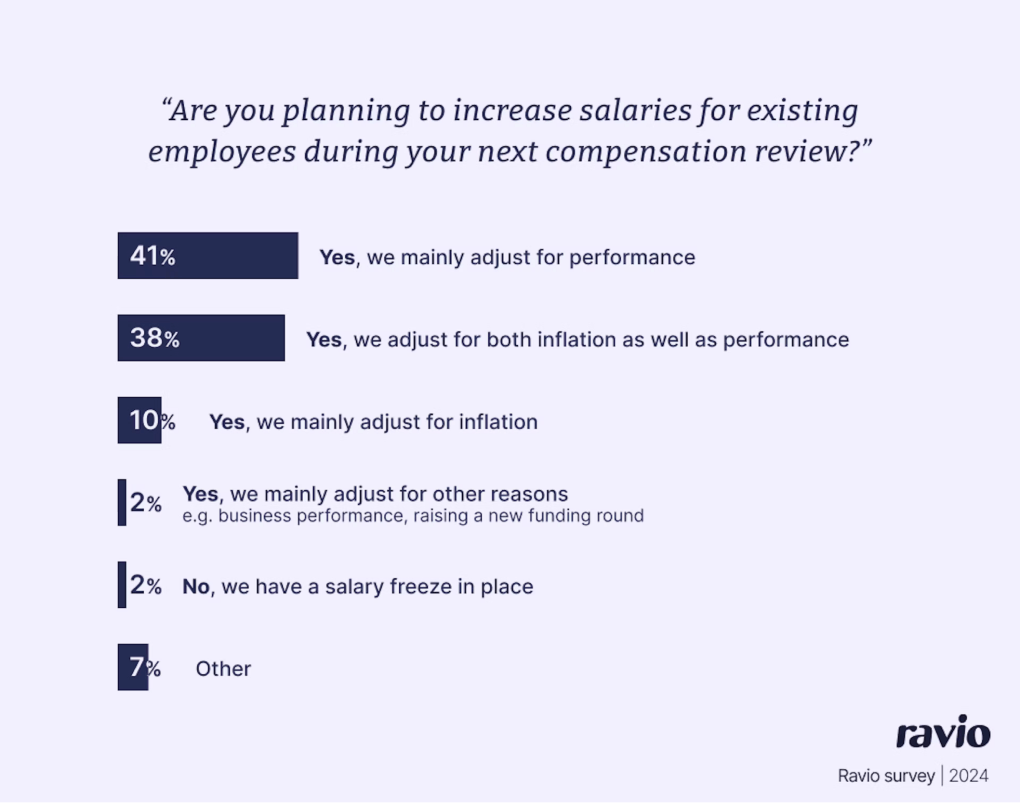
However, there are downsides of pay for performance which may make it unsuitable for some companies.
Most importantly, pay for performance can lead to pay equity issues when implemented poorly.
Performance reviews always rely, to an extent, on subjective feedback from colleagues, managers, and senior leaders. It’s very difficult to eliminate unconscious bias from this process, which can cause pay equity issues.
Plus, if base salaries are adjusted based on performance alone, then employee compensation can quickly fall behind market competitive rates – which could even lead to increased attrition risk.
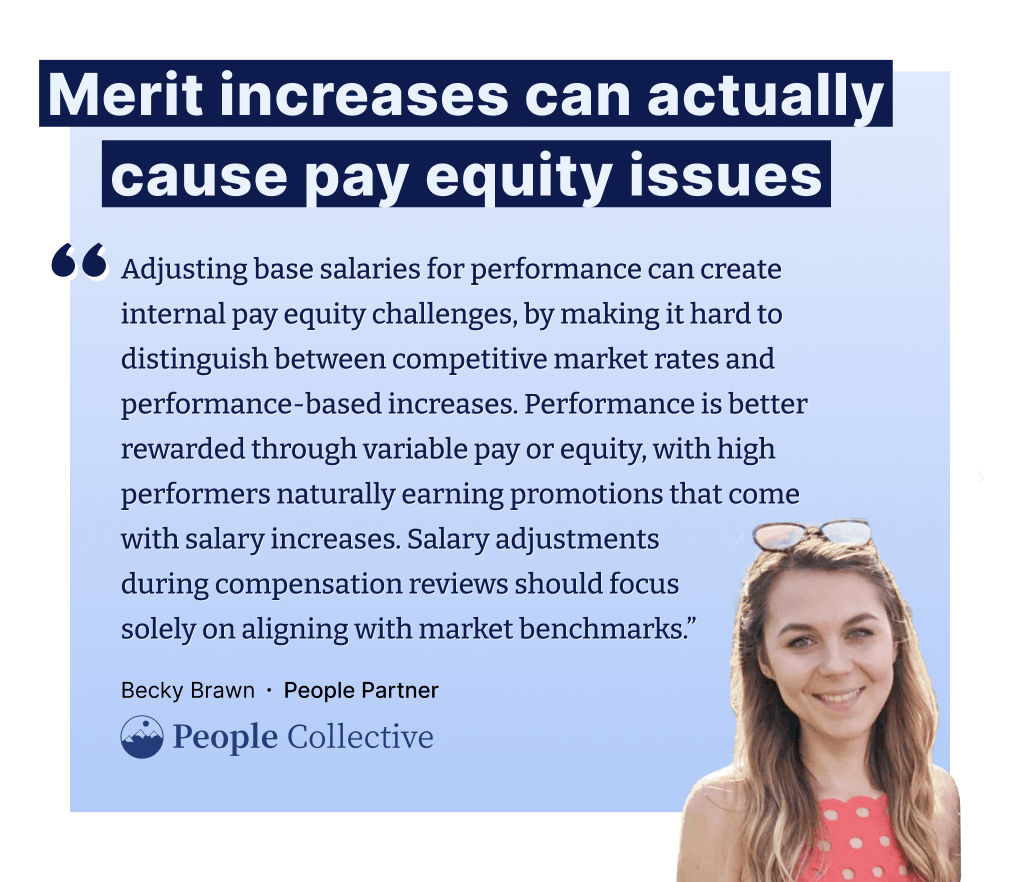
💡 Pipedrive separated performance from salary increases to improve pay equity
Founded in Estonia in 2010, Pipedrive is a sales CRM and pipeline management tool with over 1,000 employees.
In recent years, the company has experienced exponential growth, driving a decision to move away from a performance-based compensation philosophy.
Pipedrive has decoupled compensation reviews from performance ratings. The review cycle is used to align employee salaries with the latest market benchmarks, while also conducting a thorough analysis of compa ratios and internal pay equity.
High performers are still rewarded, but through annual bonus plans and a commission scheme, rather than by adjusting base salaries.
Pipedrive also encourages high-performing employees to take on new responsibilities, learn new skills, and explore other roles outside their core discipline, helping to pave the way for faster promotions and professional growth. A recognition platform further supports this by regularly highlighting employee achievements.
As Tanya Krasnova, Senior Reward and Benefits Manager at Pipedrive, explains:
“Employees no longer rely solely on annual reviews for recognition. They can trust that salary reviews will be fair and consistent, alongside opportunities for career growth and ongoing recognition”.
2. A market-based compensation philosophy
A market-based compensation philosophy focuses on how competitively an organisation wants to compensate employees when compared to their industry peers.
The most common principle for this type of compensation philosophy is to be market-aligned.
This means the philosophy targets the 50th percentile (i.e. the median market benchmark) for a company’s size, industry, or geography to determine employee salaries – as well as other compensation elements like equity and variable pay if relevant.
However, companies aiming to attract and retain top talent may target higher percentiles, such as the 75th or even 90th percentile. This is known as market-leading, where organisations go above the market rate and apply these benchmarks to their salaries as well as other compensation options like equity, competitive benefits, and performance bonuses. This is common among companies like Netflix, Google or other top tech giants.
On the other hand, some companies, particularly early-stage startups with limited budgets, may deliberately choose to pay below market rates. This is known as market-lagging. Instead of competing on compensation, they may attract employees based on things like mission alignment, future potential, or equity opportunities that offer a long-term financial upside.
Whatever the approach, whether market-aligned, market-lagging, or market-leading, companies following a market-based compensation philosophy must have access to up-to-date salary benchmarking data from a provider like Ravio in order to stay competitive.
💡Do some companies include both pay for performance and market alignment in their compensation philosophy?
Many organisations blend pay for performance and market-aligned compensation philosophies, creating a hybrid model that adjusts compensation based on both individual and company performance, as well as broader market conditions.
A merit matrix is often used to balance these factors – rewarding high performers while ensuring overall pay remains competitive and pay equity is maintained.
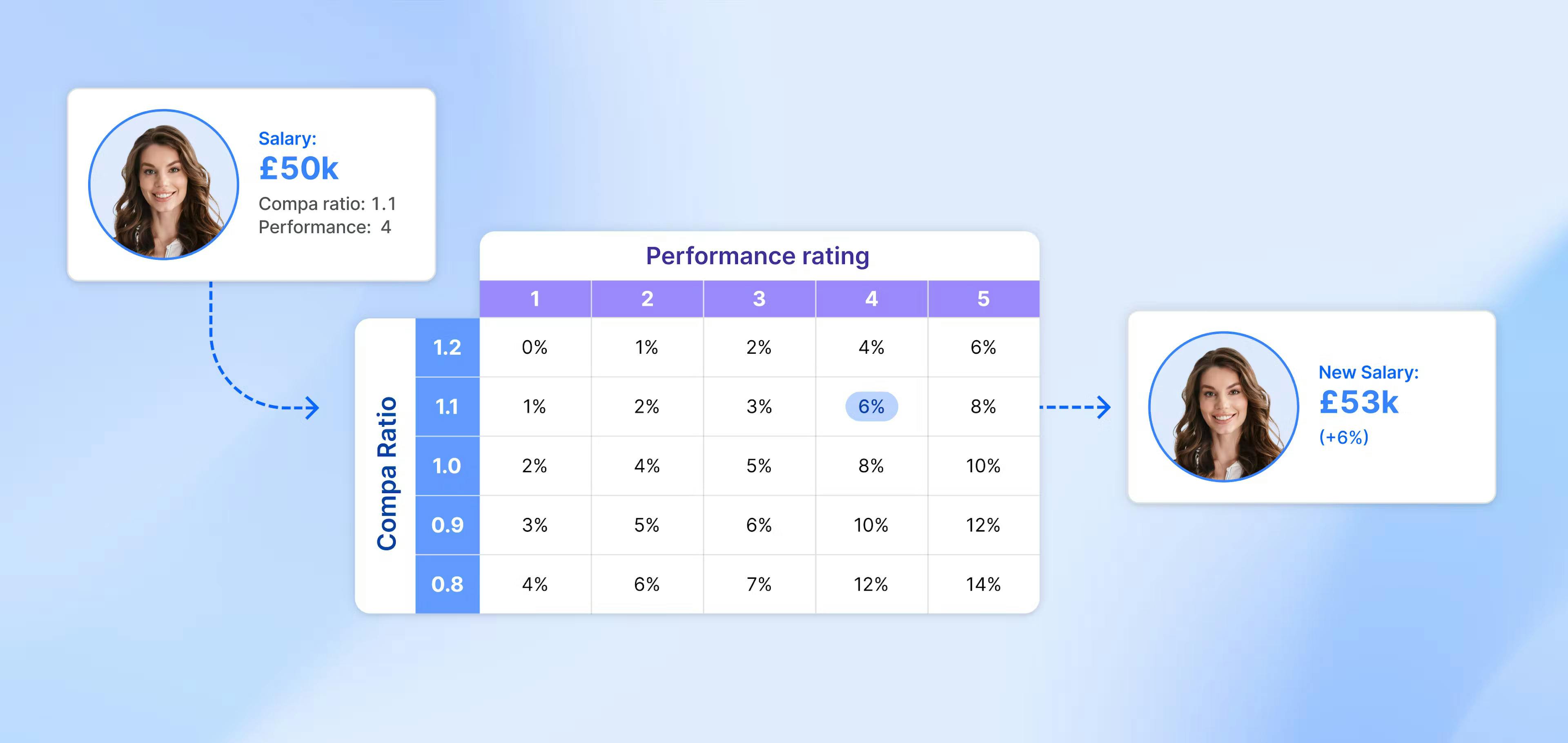
3. Location-based compensation philosophy
A location-based compensation philosophy focuses on making a conscious decision on how on whether employees will be compensated differently (or the same) based on their geographic location.
Compensation varies depending on location, so this ensures compensation aligns with local market benchmarks and reflects variations in cost of living, salary expectations, and economic conditions across regions or countries.
The most common principle for this type of compensation philosophy is fully localised pay, where salaries are tailored to match the market rate in an employee's specific location.
For example, looking at Ravio’s compensation dataset, we can see that a P3 Software Engineer’s median salary is £71,000 in London but £66,100 outside of London (correct as of January 2025) – a fairly significant regional difference.
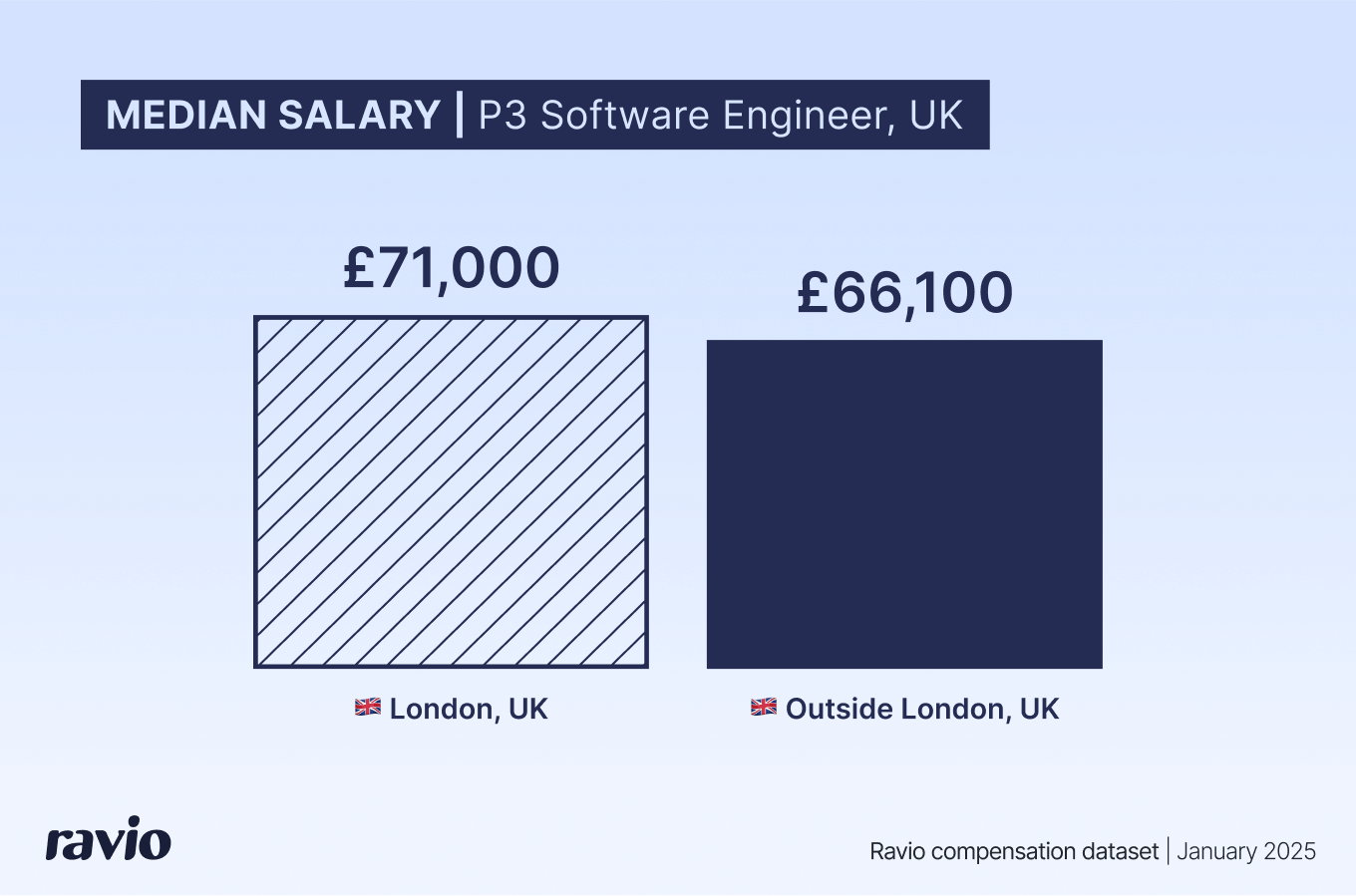
Like with market-based compensation philosophies, it’s vital that companies using a fully localised approach have access to an accurate compensation benchmarking data provider, like Ravio, to understand how compensation varies globally.
At the other end of the spectrum is location-agnostic pay, where all employees are paid the same regardless of where they live.
The pros of this approach are simplicity, rewarding employees for their contributions rather than their location, and removing geographic bias.
However, this approach can lead to higher payroll costs if the company hires extensively in high-cost locations, as salaries must be set to accommodate these markets. It can also create pay equity challenges for employees living in vastly different economic conditions.
Some companies aim for somewhere in the middle, using location tiers to group regions into categories like high cost of living, medium cost of living, and low cost of living.
Buffer is one example of a company which includes location tiers in their compensation philosophy – outlined in the compensation philosophy examples section below.
While this approach balances competitive pay with reduced complexity, it does not capture the nuances of global salary variances.
4. Equal pay compensation philosophy
An equal pay compensation philosophy is built on the principle of providing fair and consistent pay for employees who perform equal work or work of equal value, regardless of factors like gender or location.
Pay equity is increasingly becoming a core pillar of compensation, particularly driven by evolving pay transparency laws like the EU Pay Transparency Directive which seek to eliminate pay discrepancies based on gender.
Well-defined job levels, career pathways, and salary bands are vital foundations, as well as regular pay equity analyses to identify and address any discrepancies.
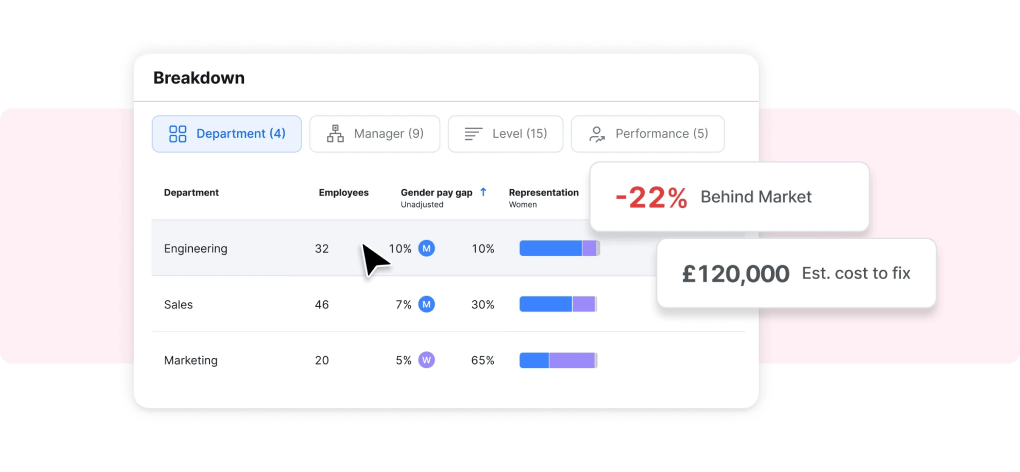
Clear, regular, and transparent communication is also a key guiding principle for compensation philosophies focused on equal pay – which companies like Buffer have embraced, openly sharing their pay structures, as we explore later on in this article.
How to create a best practice compensation philosophy
Creating a compensation philosophy tailored to your organisation’s goals, culture, and employee needs requires a thoughtful, structured approach – but what does that actually look like?
In this section, Ravio’s Chief People Officer, Vaso Parisinou, explains the 10 key steps to creating a best practice compensation philosophy:
- Step 1: Define the objectives
- Step 2: Define a set of core guiding principles
- Step 3: Ensure compliance with legislation – especially pay transparency laws
- Step 4: Seek alignment from leadership stakeholders
- Step 5: Decide your target percentile
- Step 6: Agree the total compensation approach
- Step 7: Draft the compensation philosophy document
- Step 8: Stress-test with trusted team members
- Step 9: Finalise the compensation philosophy document
- Step 10: Communicate the compensation philosophy to all employees
Step 1: Define the objectives of the compensation philosophy
As a first step, defining what the compensation philosophy aims to achieve is crucial – the key goals or objectives of the philosophy.
These objectives should not only support organisational values, but also serve as the backbone of the entire document, helping to guide and shape the decisions you make in the future.
Remember to align those objectives closely with the broader goals, strategy, and priorities of the business.
Some examples of the objectives your compensation philosophy could include are:
- “We aim to attract the best talent to join our team and provide opportunities for them to stay and grow within the company.”
- “We strive to position our organisation as a leading competitor in base pay, variable pay, and benefits, ensuring we remain competitive in the market.”
- “We are committed to bringing transparency and clarity to how compensation is determined and calculated for all employees.”
- “We want to motivate employees to perform at their best, incentivising them to achieve goals and push the boundaries of innovation through our initiatives.”
- “We prioritise ensuring pay equity, so all employees are compensated fairly for equal work of equal value.”
Step 2: Define the guiding principles of your compensation philosophy
The guiding principles will shape every compensation decision, and should closely align with your company values.
Some examples include:
- Competitive: How competitive do you want your compensation to be?
- Fair: How fair should your company be when it comes to base pay, performance bonus, equity etc.?
- Flexible: Will your employees have the opportunity to choose the make-up of their compensation package?
- Sustainable: Will you be able to iterate and grow your compensation philosophy as your company scales?
- Global: Will your compensation philosophy span different geographies, or be centered on one market only?
Vaso’s advice on deciding the right guiding principles? “Keep it simple!”
“Building your compensation philosophy is a process that never ends – every year you will iterate, make it more nuanced and aligned with where your organisation is at different stages. It’s important that, especially the first time you start out, you don’t reinvent the wheel and over-engineer it.”

Chief People Officer at Ravio
Step 3: Ensure your compensation philosophy is compliant with legislation
With pay transparency laws and gender pay gap gap reporting heightening, it's important to ensure your compensation philosophy aligns with legal requirements.
Every company should have equal pay as a core goal within the compensation philosophy, and the document should include how you intend to ensure fair pay for all employees.
Step 4: Seek alignment from leadership stakeholders
The foundation of a compensation philosophy is shaped by a company’s founders, whose vision for how employees should be rewarded determines the guiding principles.
As Vaso Parisinou, CPO at Ravio, puts it: “Conversations with leadership are crucial in the early days to get over those initial alignment hurdles.”
Her advice is to “Ensure you qualify what leadership would like to achieve through your compensation philosophy, and use that in your initial build. While you won’t get to satisfy everyone, always use data from a trusted source like Ravio to influence conversations – it’s very hard to argue against excellent data!”
Once the founders’ perspective is defined, alignment with the CFO becomes critical.
Together, the founders, CFO, and HR leader form the core group responsible for setting the direction of the compensation philosophy. Whether you are a CPO or HR and Rewards leader, your core role is translating this vision into a framework that is sustainable, defensible, and fair – balancing strategic intent with practical implementation.
After this alignment is achieved, the next step involves presenting the philosophy to the broader leadership team, whose role is to support and operationalise the pre-agreed vision, ensuring consistency and clarity across the organisation.
A thorough evaluation of the company’s financial position is also essential at this stage.
Collaboration with the CFO ensures that the compensation philosophy accounts for financial realities, balancing competitive rewards with long-term sustainability.
This structured approach creates a clear and cohesive foundation for implementing a fair and effective compensation strategy.
Step 5: Decide your target percentile
Determining your target percentile is a crucial step within a compensation philosophy, to determine how employee compensation will sit against the wider market – market-aligned, market-leading, or market-lagging.
If you’re building a compensation philosophy from scratch, Vaso suggests that “for small companies, it’s always recommended to be conservative with the pay percentile you go after initially – remember that you want to start with salaries that you can continue paying!”
Once the target percentile is determined, it’s important to then evaluate compensation benchmarking data providers in order to ensure an accurate understanding of what market competitive compensation looks like for the market you compete with.
If market-leading compensation is a core guiding principle of the compensation philosophy then it’s vital to have up-to-date, accurate benchmarking data from a real-time benchmarking provider, rather than relying on salary surveys.
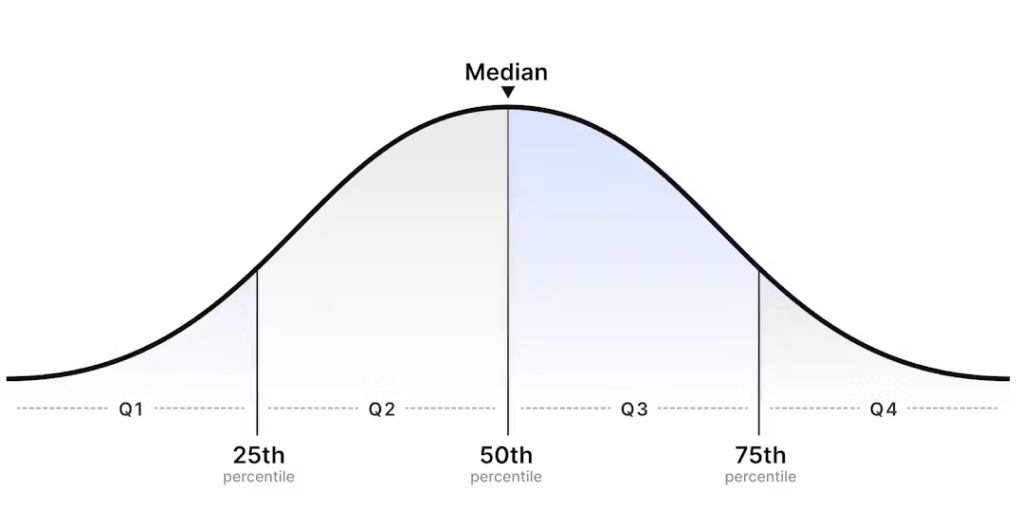
Step 6: Agree the total compensation plan
Agreeing a total compensation plan means defining which elements of compensation (cash, equity, variable pay, benefits) employees have access to, the balance of each element, and how each is used to attract, retain, and motivate employees effectively.
The total compensation plan should be shaped by your core principles, tailored to reflect the unique needs of the organisation.
For example, if competitiveness is a priority, the focus for new hires might be market-leading salaries paired with equity compensation and comprehensive benefits – and then ongoing performance bonuses and equity refresh grants to reduce attrition risk.
Alternatively, if your company is an early-stage startup that cannot compete on cash salaries, equity and long-term incentives may take centre stage for new hires and compensation reviews as a way to attract and retain employees through the potential future financial upside.
When it comes to employee benefits, a remote-first company may prioritise flexibility, offering stipends for home office setups, extra leave, or shorter workweeks.
Meanwhile, organisations focused on pay equity may enhance their benefits with policies like extended parental leave, childcare stipends, or other resources for working parents – given the impact of child-rearing on women in tech.
Total compensation may also vary across roles, if there are different objectives or team cultures at play.
For example, sales roles often include variable compensation opportunities such as commission, while high-impact positions such as software engineers in tech companies, might benefit from heightened equity allocations or other long-term rewards.
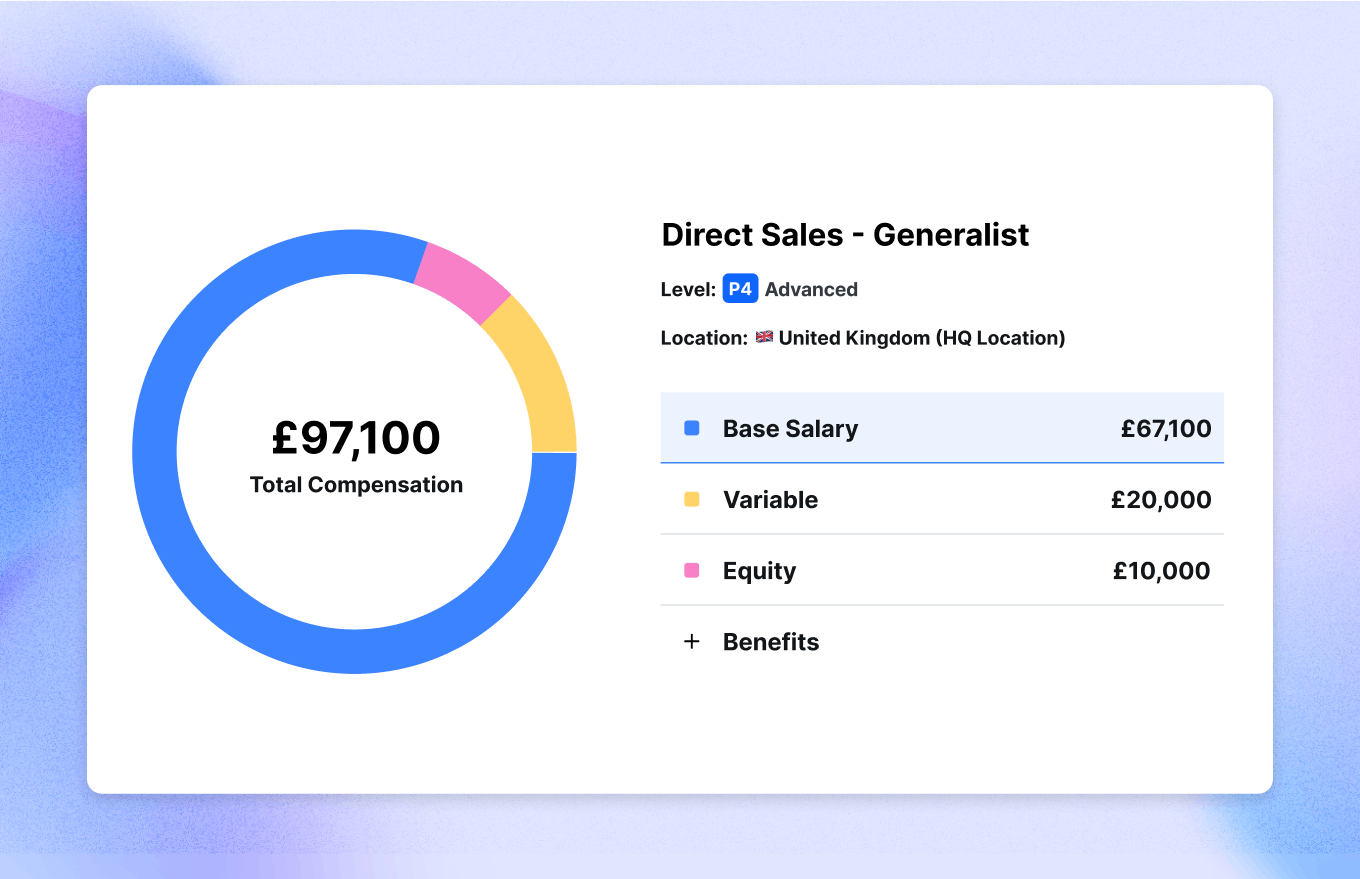
Step 7: Draft the compensation philosophy document
Now it’s time to build out your compensation philosophy document. The document should include all of the information from the previous steps:
- A summary statement of what you want to achieve
- Goals and objectives
- Guiding principles
- Commitment to pay equity
- How compensation will compare to the market
- Total compensation approach: base salary, variable pay (if applicable), equity (if applicable), benefits
- How performance will be rewarded (if applicable)
It can be whatever format makes most sense for your company – Google doc, Notion page, etc.
Step 8: Stress-test the compensation philosophy with trusted team members
After drafting the compensation philosophy, it’s vital to again seek alignment from the leadership team who will be the final approval on the document.
Vaso Parisinou, Chief People Officer at Ravio, advises also stress-testing it with a small number of trusted colleagues before sharing this more widely with the company.
“Think of this as the review or feedback stage,”, she says, “ with the aim to get a mix of people involved, including managers and individual contributors across different departments to assess their reaction and feedback.”
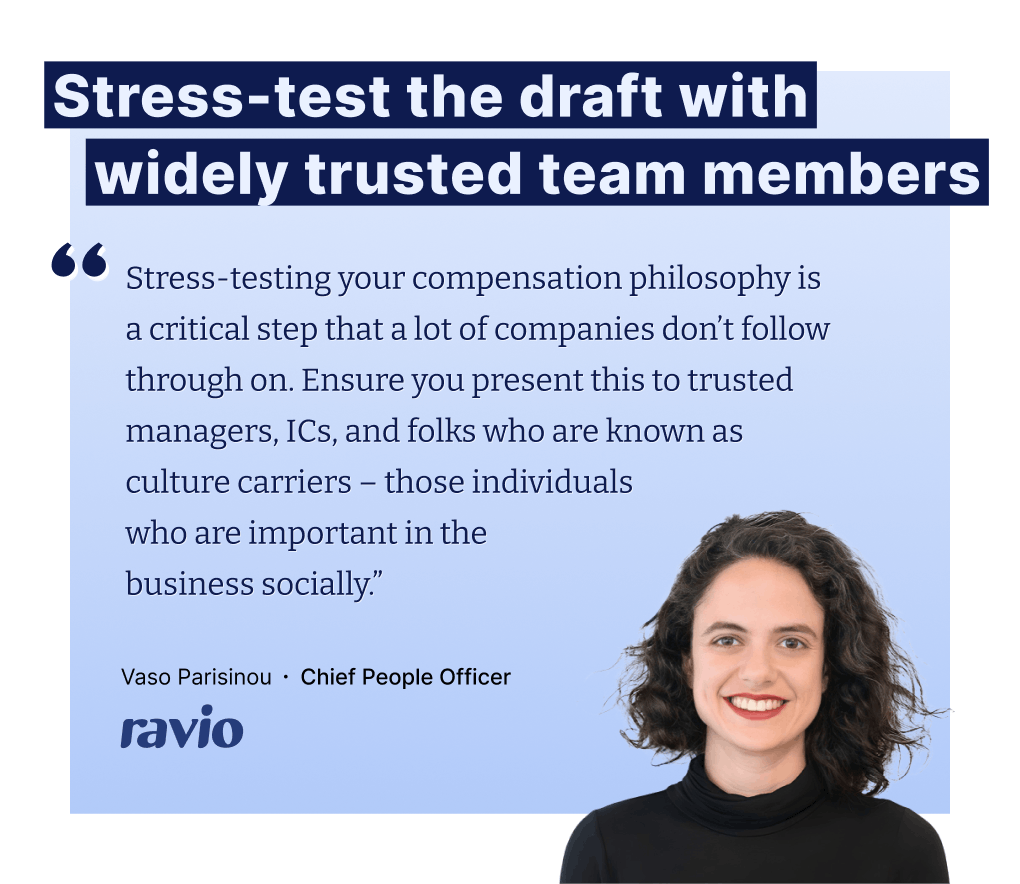
Step 9: Finalise the compensation philosophy document
Once you’ve gathered feedback from colleagues and leadership, it’s time to refine and finalise the compensation philosophy document.
Use the insights and suggestions from feedback sessions to address any gaps, clarify any points of confusion, and ensure the document aligns fully with the values, goals, and strategic priorities of your business.
After making the necessary adjustments, seek final approval from key stakeholders, including senior leadership and decision-makers – their buy-in is essential to ensure the compensation philosophy is both practical and supported across the organisation.
Step 10: Communicate the compensation philosophy to all employees
Sharing the compensation philosophy with the team is the most important part of the whole process.
Managers need to have a strong understanding of the rationale behind compensation decisions to ensure adherence during hiring conversations and compensation review processes – crucial for ensuring consistent compensation decisions are made across a company, especially as the team grows and scales.
Employees need clarity on why their compensation package is what it is and how it will progress over time, to build trust, understanding, and loyalty.

Compensation philosophy examples
Let’s take a look at examples for six well-known tech companies that have public compensation philosophies – and how they’re tailored to fit the company size, industry, and values:
- Amazon’s compensation philosophy: market-leading
- Google’s compensation philosophy: market-leading, pay for performance
- Buffer’s compensation philosophy: market-leading, equal pay
- Netflix’s compensation philosophy: market-leading
- Juro’s compensation philosophy: market-aligned, pay for performance
- Checkly’s compensation philosophy: market-aligned, pay for performance, location-based, pay transparency
1. Amazon’s compensation philosophy: market-leading
Amazon’s compensation philosophy focuses on attracting and retaining top talent through a highly competitive pay structure.
There are two main elements to Amazon’s compensation structure:
- Market-leading base salaries. Amazon’s compensation reviews focus on regular market adjustments to ensure alignment with up-to-date benchmarking data. In 2022, Amazon doubled its maximum base pay for U.S. employees from $160,000 to $350,000.
- Employee stock options. Employees receive RSUs tied to Amazon’s stock performance which vest over a 4 year period, as a retention incentive. In the first two years of employment, Amazon also provides annual payouts (formerly referred to as bonuses) which ensure employees maintain a steady income before their RSU vesting schedule begins to ramp up significantly in years three and four.
2. Google’s compensation philosophy: market-leading, pay for performance
Like Amazon, Google’s compensation philosophy is centred around providing highly competitive compensation to attract and retain top-tier talent – a hallmark of FAANG companies.
Google’s compensation philosophy is underpinned by several key principles:
- 90th percentile benchmarking. Google uses several benchmarking data providers and benchmarks compensation at the 90th percentile, ensuring that all employees, regardless of job title or salary, are compensated within the top 10% of market rates for their role.
- Regular market adjustments. Google does several compensation reviews each year, as opposed to the average annual cadence of most companies, to ensure employee pay stays competitive. Managers are also able to add discretionary salary increases based on performance.
“Every year, each employee’s compensation is modelled algorithmically, based on work-related inputs like the market rate for their job, their location, level and performance rating. If managers then want to apply discretion to adjust an employee’s modelled compensation, they must provide a clear rationale.”
- Equity for all. Employees are granted ‘Google Stock Units’ (GSUs), which vest over a four-year period, encouraging employees to stay with the company and align their financial rewards with Google's long-term success.
- Competitive benefits. Employees at Google enjoy perks such as generous wellness allowances, flexible working, generous parental leave, and student loan reimbursement. Together, this helps to attract and retain talented employees – especially if very few companies can match the list of benefits.
- Performance-based bonuses. At Google performance is rewarded through a bonus structure. Sales teams receive individual performance-based bonuses, while the rest of the company are rated on company-wide performance.
- Pay equity and transparency. Google’s compensation philosophy incorporates a strong commitment to pay equity and pay transparency. Google has been conducting its own pay equity analyses since 2012, and has publicly committed to entirely closing the gender pay gap. In 2018, Google made $9.7 million in pay adjustments to address discrepancies in offers and discretionary funds.

3. Buffer’s compensation philosophy: market-leading, equal pay
The key principles that make up Buffer’s compensation philosophy are:
- Transparency: Buffer openly shares their approach and information on all salaries to create trust, drive accountability, and serve as a public resource for a remote-first industry.
- Simplicity: Buffer aims to maintain an easy-to-understand formula that allows anyone to easily see how we arrive at any individual salary.
- Fairness: Buffer commits to ensuring employees with the same role and responsibilities are paid the same for doing equal work of equal value.
- Generosity: Buffer pays above the 50th percentile to attract top talent and avoid exceptions and inequity resulting from negotiation.
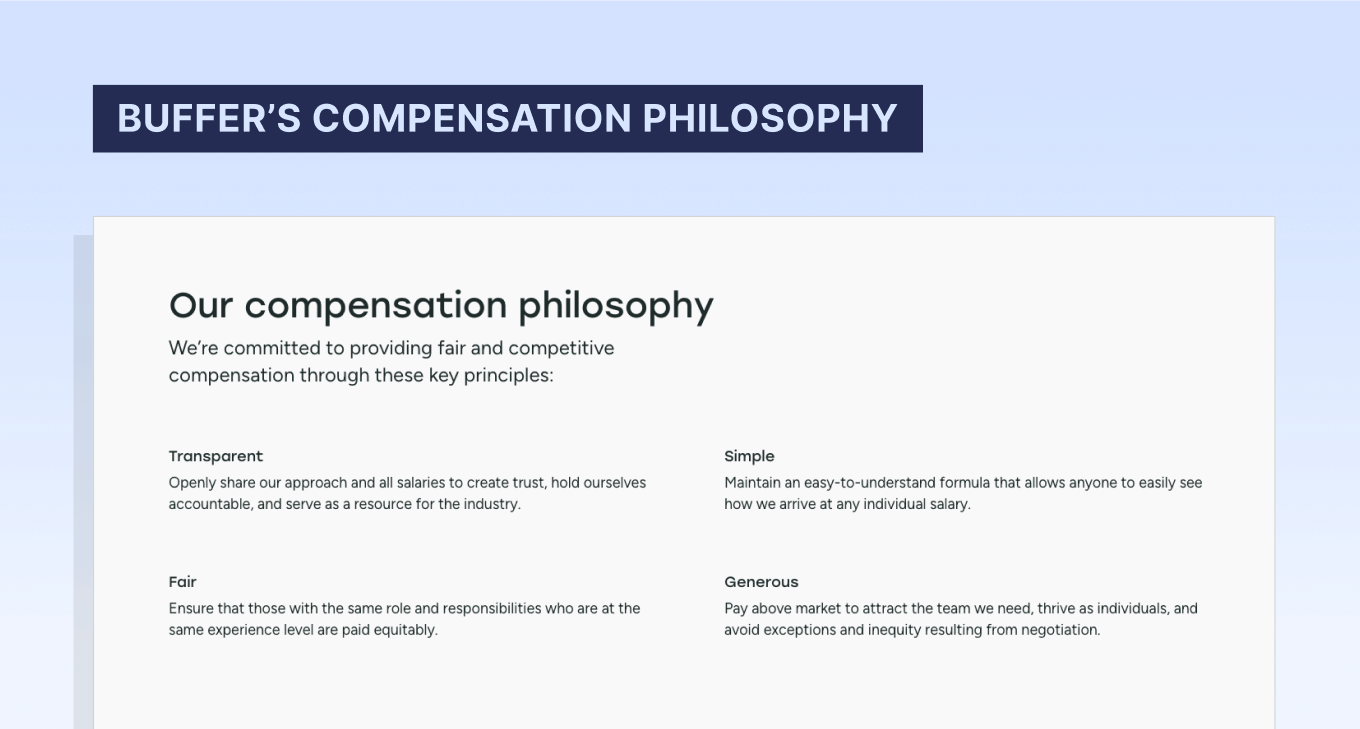
Buffer’s compensation philosophy is, therefore, market-leading, focusing on above market compensation.
There’s also a large focus on pay equity – Buffer has been working hard to make compensation as transparent as possible since 2013, even sharing all employee salaries openly on their website.
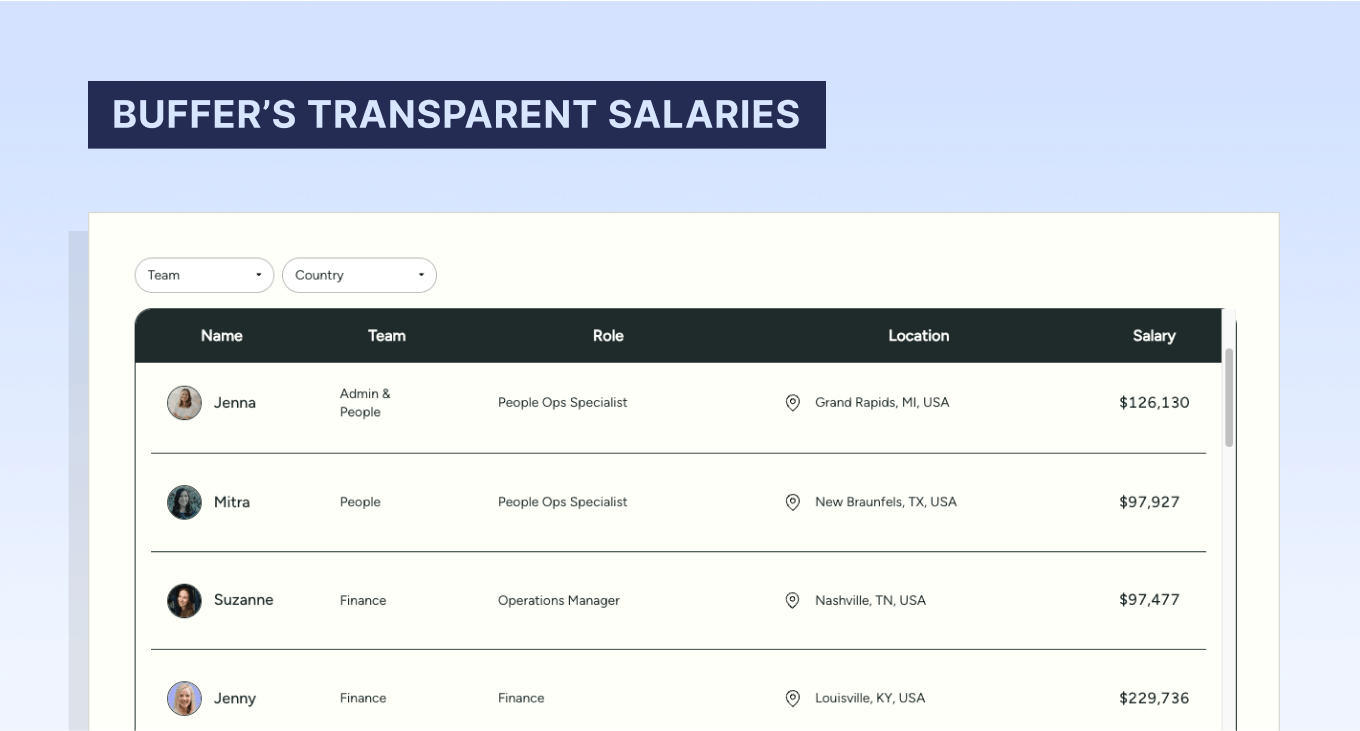
Finally, Buffer also has a location-based compensation approach. Two cost of living tiers are used when determining employee compensation, with employees in high cost of living locations like Zurich, London, and San Francisco receiving higher base salaries to account for this.
4. Netflix’s compensation philosophy: market-leading
Netflix’s compensation philosophy is one of the most market competitive out there.
There are a few key components:
- Top-of-market base salaries. Netflix pays at the top of what they call the ‘personal market’ – this is the highest possible salary paid in the market for each individual role. The aim is to pay as competitively as possible to attract the best talent. Netflix also doesn’t follow an annual compensation review process. Instead, it works to continually evaluate market benchmarks and make adjustments.
“If your market adjusts, we do not have to wait for an annual compensation event to make changes. We hope through this compensation approach, we can dismantle pay disparities across gender and race.”
- Equity for all employees. Netflix offers stock options to all employees as part of their overall compensation package. Like base salaries, equity compensation at Netflix is highly competitive. Employees get full vesting of their options from day one as well as a 10-year exercise window for up to 10 years.
- Flexible total rewards. Every employee at Netflix can choose how much of their compensation should be salary versus equity.
“Living our culture of (almost) no rules gives employees the freedom to exercise their judgment, we don’t want to make the decisions for you around your finances.”
- Keeper Test. Central to Netflix’s compensation philosophy is the Keeper Test, where employees who do not meet Netflix’s high working standards are proactively exited from the company with a generous severance package.
5. Juro’s compensation philosophy: market-aligned, pay for performance
Juro’s compensation philosophy blends a market-based approach and pay for performance, with the following guiding principles:
- Competitive: Compensation is based on role, level, and location, ensuring pay is aligned with or exceeds market standards.
- Sustainable: Processes are refined to balance competitive compensation with the company’s financial stability and growth.
- Accessible: The pay framework is designed to be transparent and easily understandable for employees, backed by clear data and communication.
- Global: Compensation is reviewed and adjusted for employees relocating to different regions or countries.
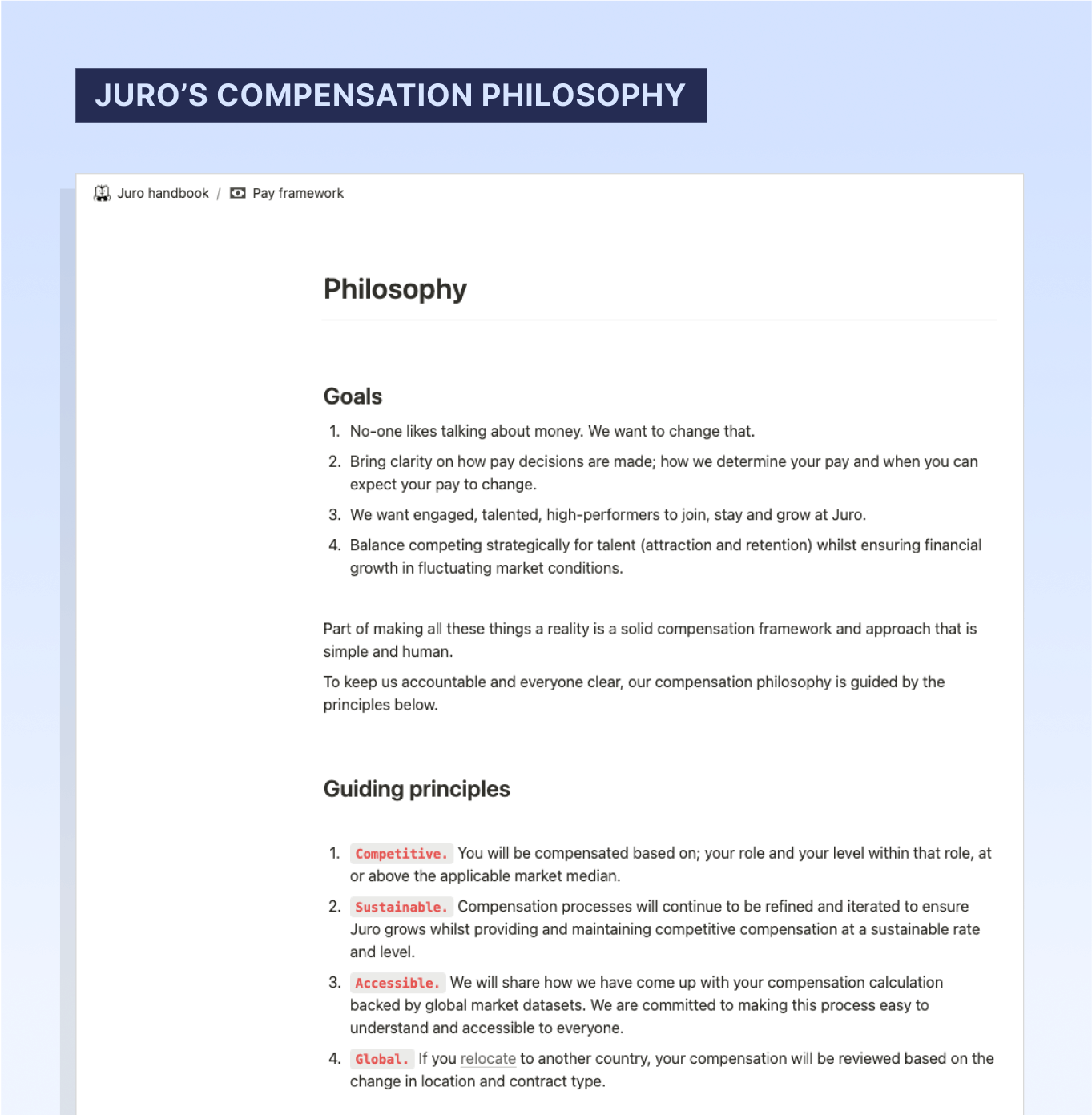
All employees at Juro receive a total compensation package which is at or above market median benchmarks for base salary and equity compensation, as well as including a range of employee benefits.
Juro then rewards performance through performance-based bonuses and on-target earnings (OTE). Company-wide performance retros occur twice a year to assess individual achievements and determine these performance rewards. These retros are separate from compensation reviews – which focus solely on market alignment.
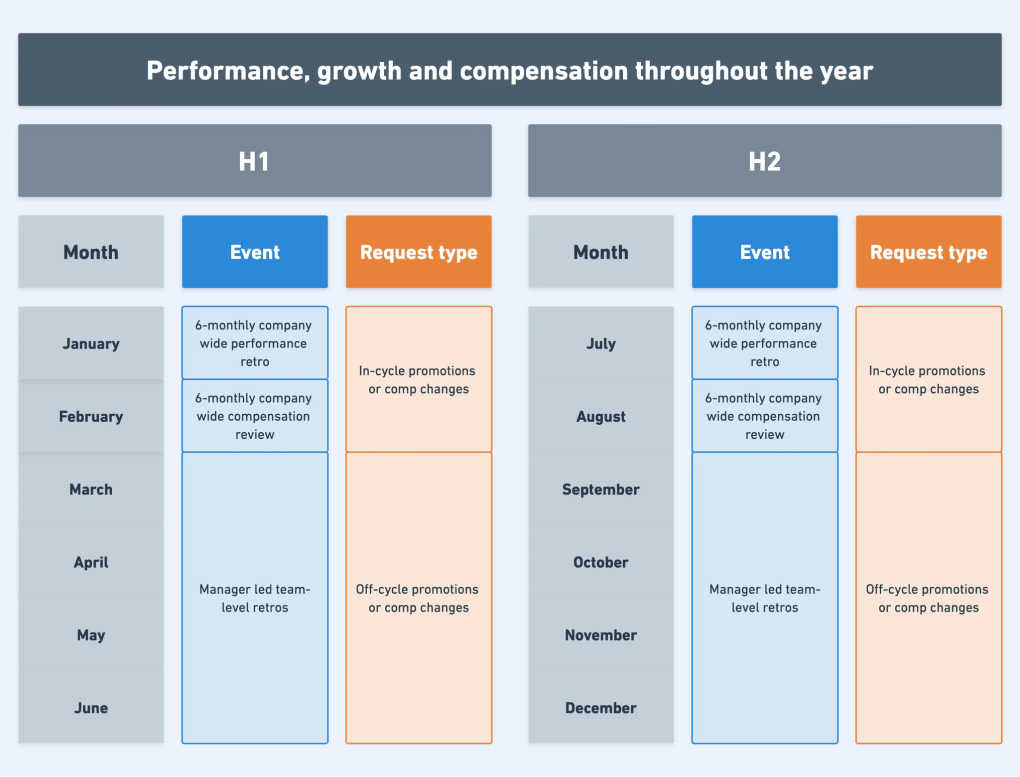
6. Checkly’s compensation philosophy: market-aligned, pay for performance, location-based, pay transparency
Checkly’s compensation philosophy focuses on market alignment, rewarding performance, accounting for location differences, and pay transparency.
Checkly’s compensation philosophy includes the following core principles:
- Market-aligned salaries. Checkly offers competitive and generous salaries for all employees, aiming to align with or exceed market benchmarks. Benchmarks are reviewed annually, and employees are encouraged to inform the People team if they receive another offer above their current pay.
- Performance multipliers. Checkly builds performance-based progression into the salary band structure to provide opportunities to increase base pay without needing a full promotion to the next level. There are three steps for each salary band: learning (0.9), comfortable (1.0): consistently meeting expectations for the role, and thriving.
- Location adjustments. Checkly incorporates regional cost-of-living differences into its pay formula to ensure equitable compensation across its global team. Location factors range from 0.85 for lower-cost areas to 1.5 for high-cost cities like San Francisco or New York, helping to ensure fairness while remaining competitive in key markets.
- Transparent approach. Pay transparency and strong employee communication is important to Checkly as a company. As well as publicly sharing their compensation philosophy, Checkly has also made their approach to determining the salary for each role public through a salary calculator too.
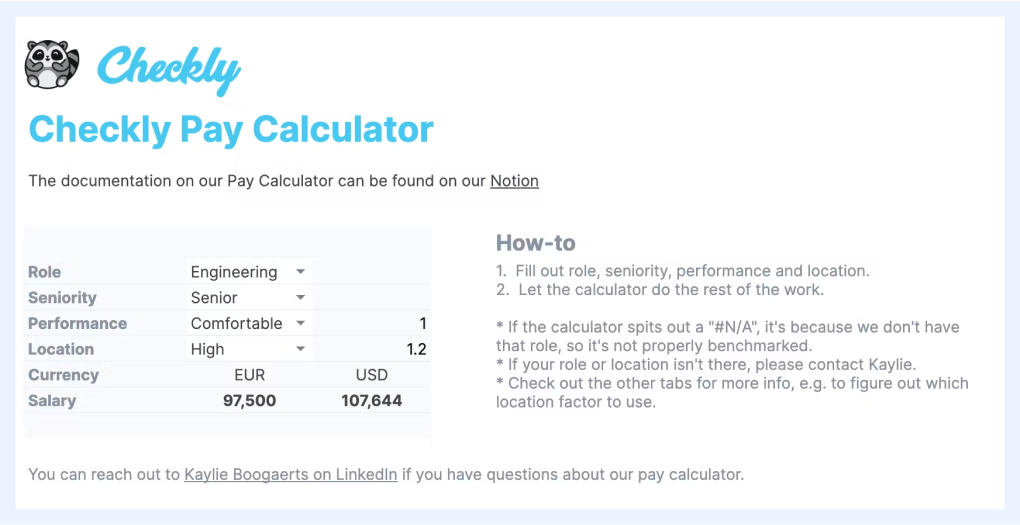
How Ravio helps you to keep pay decisions aligned with your compensation philosophy
Ravio’s compensation management software can help ensure decisions stay consistent, regardless of which guiding principles you opt for within your compensation philosophy.
Ravio for a pay for performance compensation philosophy
Running a structured compensation review that accounts for performance ratings as well as keeping employee pay in line with the market, whilst also rolling out additional compensation components like equity refresh grants or performance bonuses, is complex.
Ravio’s compensation review product brings all of the important elements together (employee data, compensation framework, reliable benchmarks, and intuitive salary bands) in one, user-friendly platform.
"I cannot believe I'm feeling excited to use a comp review product. Let's get rid of our Excels. This is going to be so much easier." – Ravio beta testing customer
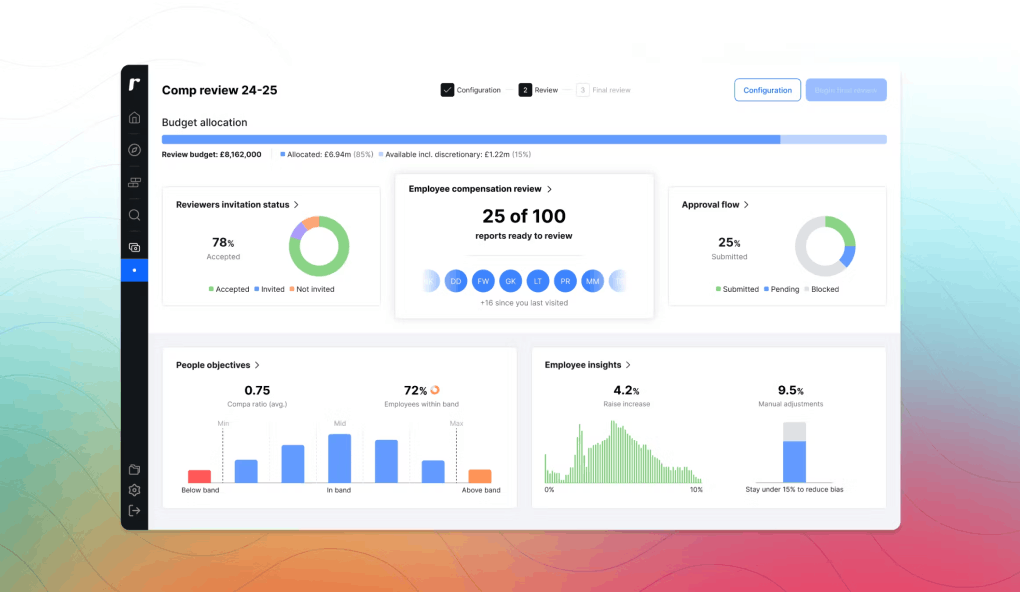
Ravio for a market-based compensation philosophy
Companies following a market-based compensation philosophy must have a clear understanding of market competitive compensation, in order to accurately position their own compensation packages for new hires and make market adjustments for existing employees.
If being market-aligned or market-leading is a top priority, then salary survey providers like Radford and Mercer, aren't always the best option to go with – the market fluctuates constantly, and salary surveys provide point-in-time data only.
Instead, real-time compensation benchmarking software like Ravio’s enables companies to stay on top of the latest market shifts at all times.
Plus, it’s easy to filter data by industry, geography, company size, and funding stage to compare salaries against the most relevant peer groups for your business, ensuring your benchmarks are not only accurate but also tailored to your unique needs.
Ravio’s salary bands tool enables you to refresh bands in-line with the latest market benchmarks effortlessly and see where adjustments are needed to keep employees aligned with the chosen target percentile.
The compensation review module then makes it simple to apply these updates, ensuring salary adjustments are fair, equitable, and aligned with market trends.
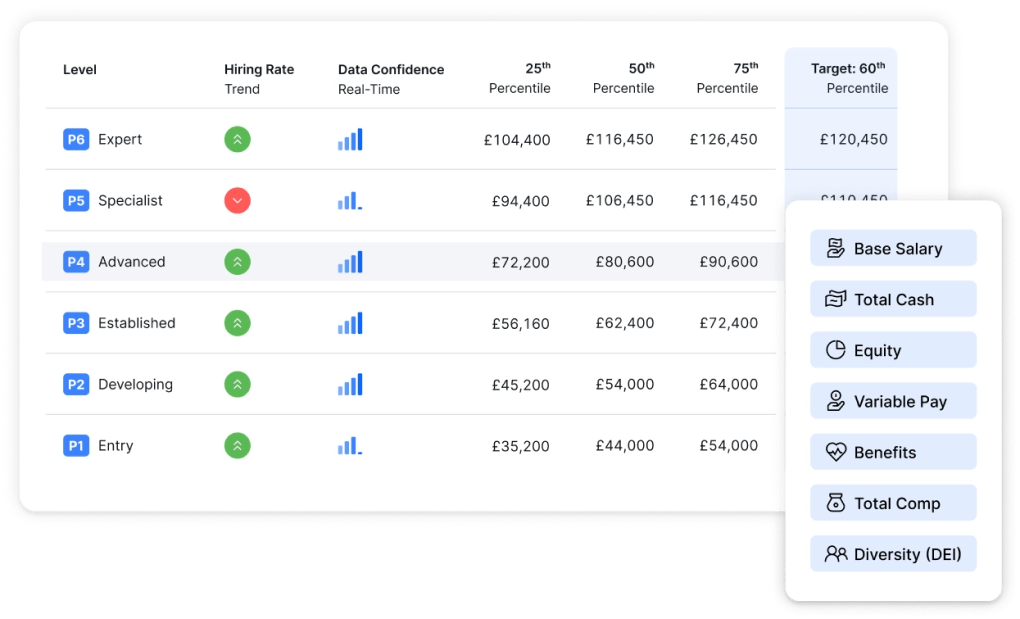
Ravio for a location-based compensation philosophy
Understanding how compensation actually varies across different locations is core to a location-based compensation philosophy – a simple cost of living calculation doesn’t capture all of the nuanced variance.
Access to accurate global compensation benchmarking data is fundamental, which Ravio provides. Plus, with Ravio’s salary band tool you can easily build and refresh location-specific salary bands.

Ravio for an equal pay compensation philosophy
It’s most common for pay inequities to arise at the point of hiring due to biases in the hiring process. Ravio’s real-time marketing benchmarking data makes it easy to make offers based on market competitive pay, rather than ad hoc decisions – keeping pay gaps lower from the very beginning.
From then on, Ravio enables pay equity analysis within the salary bands tool, to highlight where there may be pay discrimination causing outliers or discrepancies, and in Ravio’s pay equity tool, where more detailed pay equity analysis enables company-wide issues to be identified and addressed.
